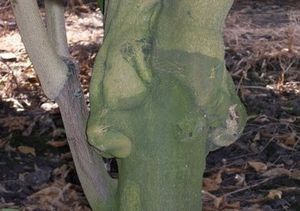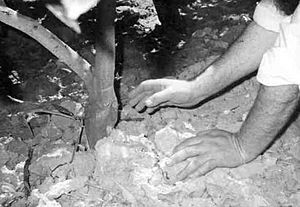Diamante citron facts for kids
Quick facts for kids Diamante Citron |
|
|---|---|
 |
|
| Species | C. medica |
| Cultivar | var. vulgaris Risso or cedro di Calabria |
| Marketing names | Yanover esrog |
The Diamante citron is a special kind of citron fruit. It gets its name from the town of Diamante in Calabria, a region on the south-western coast of Italy. This area is famous for growing these citrons. Because of its origin, people sometimes call it the "Calabria Esrog". "Esrog" is the Hebrew name for citron, often used by Ashkenazi Jewish people.
Contents
History of the Diamante Citron
The Diamante citron was once very important for making candied fruit. Large factories in Livorno, Italy, used it. They collected citrons from places like Liguria, Naples, Calabria, and Sicily. Then, they shipped the candied fruit to countries like England and the United States.
Why it's called Yanover Esrog
Many religious Jews call this fruit the Yanover Esrog. This means "Genoa citron." It got this name because the city of Genoa in northern Italy was a big trading port. Genoa exported these citrons to many other countries for a long time.
Genoa and the surrounding region of Liguria have a long history of growing citrons. A large mountain range, the Apennines, protects the area from strong winds. This makes it a good place for citrons to grow.
Genoa was also a well-known seaport and a center for banking. This meant they could trade citrons grown in other parts of Italy, like Corsica and Calabria. Because of this long history, the Calabrian citron is very traditional for the Jewish ritual during the holiday of Feast of Tabernacles.

Some Jewish groups, like the Chabad Hasidim, really prefer the Diamante citron from Calabria. They even have a story that says Moses himself got his esrog from this area. Other Hasidic groups, like the Satmars, also use it a lot.
Keeping Citrons Kosher
Famous poets like Byron and D'Annunzio admired the citron in Calabria. However, it is mostly the Jewish tradition that has helped keep this special fruit from disappearing.
Calabria is in southern Italy and has a Mediterranean climate. This climate is very good for growing citrons. Even so, winters can still be too cold for the trees. Farmers often protect them with blue or green plastic covers.
Most citron trees in the area are grafted. This means parts of two different plants are joined together. Farmers do this to protect the trees from frost and diseases. However, fruits from grafted trees are not considered kosher for the Sukkot ritual.
How Kosher Citrons are Chosen
To make sure a citron is kosher, special inspectors called mashgichim must check the trees carefully. They need to confirm that the tree has not been grafted.
Every year, a Jewish group from Israel visits Santa Maria del Cedro in Calabria. They come between July and August to choose the best fruits for the Jewish holiday. Choosing the fruit is a very important process.
The mashgichim go to the citron farms early in the morning. Each one is followed by a worker carrying a box and scissors. The mashgiach walks slowly, looking closely at the trees. They stop and examine the bottom of the tree trunk, where it comes out of the ground. If the trunk is smooth, it means the tree has not been grafted. This means the fruit can be picked. The mashgiach might even lie on the ground to get a better look at the lower branches.

Once a good fruit is found, the mashgiach shows it to the worker. The worker cuts it off, leaving a small piece of the stalk. The mashgiach then checks the picked citron one more time. If it is good enough, they wrap it in oakum (a type of fiber) and put it in a box. The farmer gets paid for each fruit picked. The boxes are then sealed and sent to the Lamezia Terme International Airport. From there, they go to Tel Aviv, Israel.
While diamante citrons are also grown in places like Puerto Rico, Sicily, and Sardinia, their fruits are not used for the Jewish ritual. This is because they did not have kashrut (kosher) certification when they were first planted there. However, seeds and cuttings from inspected trees have been planted in the Israeli village of Kfar Chabad. These trees have hechsher certification from major kosher organizations.
The ways to check if a tree is grafted or not were decided by a group of rabbis in Israel in 1877. These methods were written down in a book called Kuntres Pri Etz Hadar, published in Jerusalem a year later.

